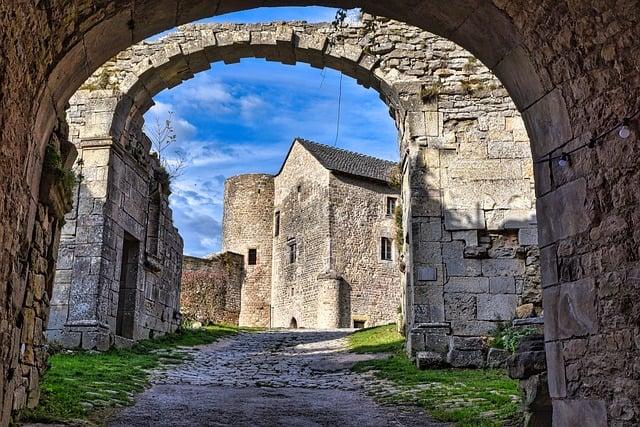In a dimly lit hall, the scent of roasted meats filled the air as villagers gathered for the Christmas feast. A boar, its skin crackling, was the centerpiece, surrounded by platters of spiced pies and honeyed fruits. Peasants savored hearty stews of barley and root vegetables, while nobles indulged in delicacies like peacock and swan, their feathers artfully arranged. Mulled wine flowed freely, warming spirits as laughter echoed. As the night wore on, the crackling fire illuminated faces, each bite a reminder of the season’s bounty and the joy of togetherness.
Table of Contents
- Exploring the Festive Feasts of Medieval Christmas
- Seasonal Ingredients and Their Significance in Yuletide Dishes
- Traditional Cooking Methods and Their Influence on Flavor
- A Modern Twist: Recreating Medieval Christmas Recipes Today
- Q&A

Exploring the Festive Feasts of Medieval Christmas
During the medieval Christmas season, feasting was a grand affair, reflecting the wealth and status of the host. Tables were laden with an array of dishes that showcased the culinary skills of the time. **Roast meats** were the centerpiece, with options ranging from **pork and beef** to more exotic fare like **peacock and swan**, often served with their feathers for dramatic effect. Accompanying these meats were **rich gravies** and **sauces**, flavored with spices such as cinnamon, cloves, and nutmeg, which were highly prized and often imported. Vegetables were also present, though they were less celebrated; **cabbage, leeks, and turnips** made frequent appearances, often prepared in hearty stews or pies.
Desserts during this festive period were equally extravagant, with **mince pies** and **spiced cakes** taking center stage. These sweet treats were often filled with a mixture of dried fruits, nuts, and spices, symbolizing the abundance of the season. **Sugar**, a luxury item, was used sparingly but with great flair, often to create elaborate confections. To wash it all down, **mulled wine** and **spiced ale** were popular choices, warming the spirits of all who gathered around the table. The medieval Christmas feast was not just a meal; it was a celebration of community, abundance, and the joy of the season, where every dish told a story of tradition and festivity.
Seasonal Ingredients and Their Significance in Yuletide Dishes
During the medieval Christmas season, the kitchen was a vibrant tapestry of flavors, colors, and aromas, all woven together by the availability of seasonal ingredients. **Root vegetables** such as carrots, parsnips, and turnips were staples, providing sustenance during the cold months. These hearty vegetables were often roasted or stewed, enhancing their natural sweetness and making them a comforting addition to festive feasts. **Herbs** like sage, thyme, and rosemary were also prominent, not only for their flavor but for their medicinal properties, believed to ward off illness during the winter months. The use of **spices** such as cinnamon, nutmeg, and cloves, which were imported and thus considered luxurious, added a touch of opulence to dishes, reflecting the wealth and status of the household hosting the celebration.
Meat played a central role in medieval Christmas banquets, with **poultry** like goose and swan often taking center stage. These birds were typically stuffed with a mixture of fruits, nuts, and spices, creating a rich and savory dish that delighted the senses. **Game meats**, such as venison and wild boar, were also popular, showcasing the bounty of the hunt and the importance of feasting during the holiday. Accompanying these meats were **dried fruits** like figs, raisins, and apples, which not only added sweetness but also symbolized abundance and prosperity. The combination of these seasonal ingredients not only nourished the body but also celebrated the spirit of the season, bringing families and communities together in a shared experience of joy and gratitude.

Traditional Cooking Methods and Their Influence on Flavor
In medieval times, the art of cooking was deeply intertwined with the available resources and the methods employed in the kitchen. Traditional techniques such as roasting, boiling, and stewing were not merely practical; they were essential for enhancing the flavors of the ingredients. Roasting over an open flame imparted a smoky richness to meats, while boiling allowed for the melding of flavors in hearty broths. Stews, often simmered for hours, became a canvas for spices and herbs, transforming simple ingredients into complex dishes that delighted the palate.
The influence of these cooking methods extended beyond mere taste; they also reflected the cultural and social practices of the time. For instance, the use of spices like cinnamon, cloves, and pepper in festive dishes was a sign of wealth and status, as these ingredients were often imported and costly. The communal aspect of cooking, where families gathered around the hearth, fostered a sense of togetherness, making the flavors of the season even more significant. As a result, the meals enjoyed during Christmas were not just about sustenance; they were a celebration of tradition, community, and the rich tapestry of medieval life.

A Modern Twist: Recreating Medieval Christmas Recipes Today
Reimagining medieval Christmas recipes can be a delightful culinary adventure, allowing us to explore flavors and techniques that have largely faded from modern kitchens. Imagine a festive feast featuring **spiced meats**, such as roasted venison or boar, seasoned with a blend of herbs and spices that would have been prized in the Middle Ages. Accompanying these hearty dishes, you might serve **pottage**, a thick stew made from seasonal vegetables and grains, simmered to perfection. For a touch of sweetness, consider crafting a **mince pie** filled with dried fruits, nuts, and a hint of spice, reminiscent of the original recipes that were more savory than the sugary treats we know today.
To bring these historical flavors to life, you can experiment with **traditional cooking methods** like spit-roasting or baking in a wood-fired oven, which can impart a unique depth of flavor. Incorporating ingredients such as **sorrel**, **chestnuts**, and **honey** can also add authenticity to your dishes. For a festive drink, try brewing a warm **spiced ale** or a **wassail**, a traditional punch made with cider, spices, and sometimes even a splash of brandy. By blending these ancient recipes with contemporary cooking techniques, you can create a Christmas feast that not only honors the past but also delights the palate of today’s diners.
Q&A
-
What were the main dishes served during Christmas in medieval times?
During medieval Christmas feasts, the menu often included:
- Roast meats: Such as boar, goose, and peacock.
- Pies: Often filled with meat or fruit, known as ‘pyes.’
- Fish: A staple during the fasting period leading up to Christmas.
- Spiced wines: Mulled wine was a popular festive drink.
-
How did social class affect Christmas meals?
Social class played a significant role in the Christmas feast:
- Nobility: Enjoyed extravagant banquets with multiple courses and exotic dishes.
- Peasants: Had simpler meals, often consisting of bread, pottage, and whatever local produce was available.
- Common ingredients: While the wealthy indulged in rare spices, the lower classes relied on basic staples.
-
Were there any special traditions associated with Christmas food?
Yes, several traditions were tied to Christmas meals:
- Feasting: The 12 days of Christmas were celebrated with feasting and merriment.
- Yule log: A log was burned in the hearth, symbolizing warmth and light during the winter.
- Charity: Sharing food with the less fortunate was a common practice during the festive season.
-
What role did spices play in medieval Christmas meals?
Spices were highly valued and played a crucial role:
- Flavor enhancement: Spices like cinnamon, cloves, and nutmeg were used to enhance the flavor of dishes.
- Status symbol: The use of exotic spices indicated wealth and social status.
- Preservation: Some spices also helped in preserving food during the winter months.
As we close the chapter on medieval Christmas feasts, it’s clear that these festive gatherings were a tapestry of flavors and traditions. From roasted meats to spiced ales, each dish tells a story of culture and celebration, echoing through the ages.




